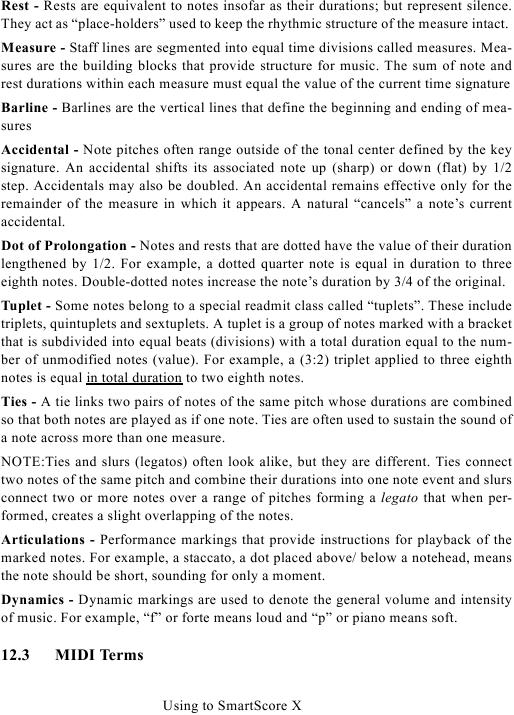Rest - Rests are equivalent to notes insofar as their durations; but represent silence.
They act as "place-holders" used to keep the rhythmic structure of the measure intact.
Measure - Staff lines are segmented into equal time divisions called measures. Mea-
sures are the building blocks that provide structure for music. The sum of note and
rest durations within each measure must equal the value of the current time signature
Barline - Barlines are the vertical lines that define the beginning and ending of mea-
sures
Accidental - Note pitches often range outside of the tonal center defined by the key
signature. An accidental shifts its associated note up (sharp) or down (flat) by 1/2
step. Accidentals may also be doubled. An accidental remains effective only for the
remainder of the measure in which it appears. A natural "cancels" a note's current
accidental.
Dot of Prolongation - Notes and rests that are dotted have the value of their duration
lengthened by 1/2. For example, a dotted quarter note is equal in duration to three
eighth notes. Double-dotted notes increase the note's duration by 3/4 of the original.
Tuplet - Some notes belong to a special readmit class called "tuplets". These include
triplets, quintuplets and sextuplets. A tuplet is a group of notes marked with a bracket
that is subdivided into equal beats (divisions) with a total duration equal to the num-
ber of unmodified notes (value). For example, a (3:2) triplet applied to three eighth
notes is equal in total duration to two eighth notes.
Ties - A tie links two pairs of notes of the same pitch whose durations are combined
so that both notes are played as if one note. Ties are often used to sustain the sound of
a note across more than one measure.
NOTE:Ties and slurs (legatos) often look alike, but they are different. Ties connect
two notes of the same pitch and combine their durations into one note event and slurs
connect two or more notes over a range of pitches forming a legato that when per-
formed, creates a slight overlapping of the notes.
Articulations - Performance markings that provide instructions for playback of the
marked notes. For example, a staccato, a dot placed above/ below a notehead, means
the note should be short, sounding for only a moment.
Dynamics - Dynamic markings are used to denote the general volume and intensity
of music. For example, "f" or forte means loud and "p" or piano means soft.
12.3
MIDI Terms
Using to SmartScore X

